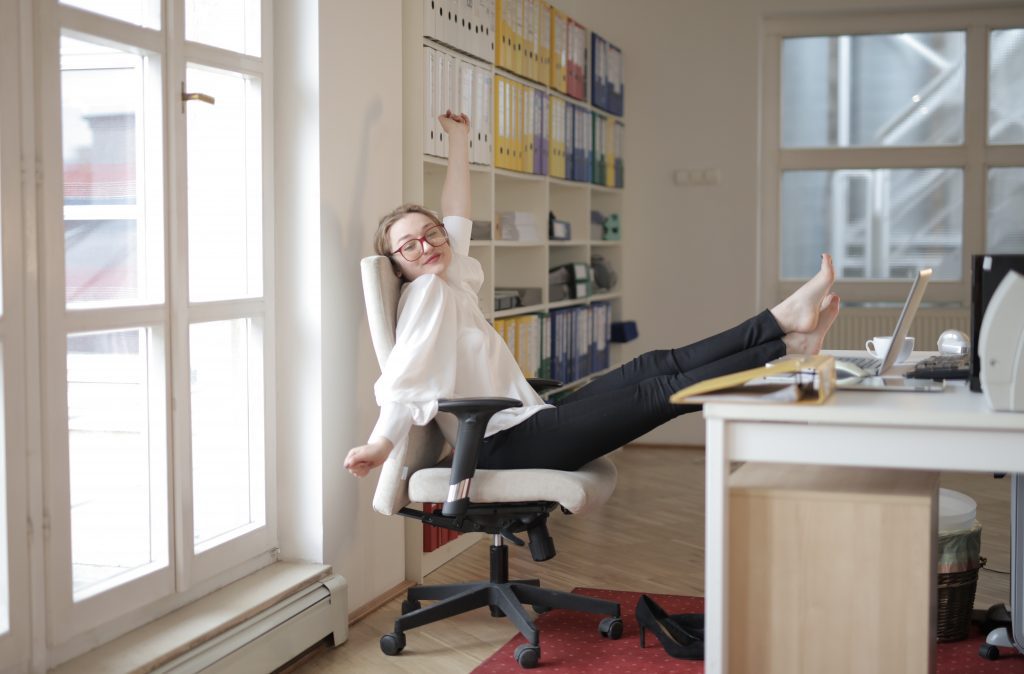How can desk stretches while you work improve your health and mobility?
Modern work for many people involves sitting at a desk working on your computer for 8 hours per day. Combine that with slouching over your smartphone, your tablet, hunching over your steering wheel, and sitting an average of 6.5 hours a day — it’s a recipe for neck pain, back pain, and general discomfort.
This desk-bound and 9-5 lifestyle has become normalized in our society, but that doesn’t mean that it’s healthy.
In fact, sitting for too long has been linked to increased risk of cardiovascular disease, obesity, high blood sugar, abnormal cholesterol levels, and more. Not to mention that the great majority of Americans have back and/or neck pain as well, which could be connected to this sedentary lifestyle.
But what can you do? This is your job, after all, and standing desks aren’t for everyone.
The good news is that there are ways to counteract the negative effects of near constant sitting without having to head to the gym for hours per day or sitting on an exercise ball at your desk.
Taking frequent breaks to do desk stretches can counteract negative effects, reduce stiffness & pain, and help you feel a bit better. Yes, that’s right, you don’t even have to leave your desk!
Here are Dr. Scott Rosner’s recommendations on stretches for desk workers to help reduce your daily discomfort, improve mobility, and continue your health journey on your own.
1. Exaggerated Nods
One of the best stretches to combat tech neck, exaggerated nods are simple and easy stretches that benefit your neck, back, and shoulders.
Imagine you’re nodding “yes” in the most exaggerated way you can. Slowly lift your head to look straight up at the ceiling. Savor the stretch, allowing yourself to stay in that position for 5-10 seconds.
When you’re ready, slowly drop your chin to your chest. If your neck stiffness or mobility won’t allow you to touch your chin to your chest comfortably, don’t force it. Let gravity pull your head down, feeling the skin on the back of your neck and back stretch.
Repeat this process 5-10 times.
2. Behind the Chair Back Stretch
Like the exaggerated nods, this stretch doesn’t require you to even get up from your chair.
Simply take your arms and wrap them behind and around your desk chair; it’s almost like a backwards hug. You can grab onto your hands, your wrists, or your forearms to keep the position.
Once you’ve got your position set, move your chest forward and up by arching your back to stretch both your upper and lower back muscles. Try to hold the stretch for 20-30 seconds before relaxing.
Repeat 3-5 times.
3. Wrist Stretch
Your wrists and arms are often forgotten in lieu of worrying about back pain, neck pain, injuries, etc.
Wrist pain is usually a result of repetitive motions (think manual labor, typing, athletic motions, etc), sports injuries (falling on a skateboard, landing on your wrist in football, etc), and various conditions (arthritis, osteoporosis, etc).
Place your palms together in front of the middle of your chest with your elbows at as close to a 90 degree angle as possible. Push your hands together to really feel that stretch in your wrists and forearms. Keep this position for about 15 seconds.
Next, flip your hands so the backs are touching, but keep the same position as before. Push your hands together, pushing your elbows slightly down as you do so to feel the stretch. Do this for about 15 seconds.
4. Seated Toe Touches
While sitting in your desk chair, straighten out your legs in front of you. Then, slowly reach your hands towards your toes to get a great upper body stretch. Flex your toes towards your body as you do so to get a calf and hamstring stretch at the same time.
If you’re feeling flexible, you can try a slight forward fold, moving your stomach towards the top of your thighs at letting your head fall to the chest and stabilizing yourself with your hands on the seat of the chair.
Either way, hold the position for 15-30 seconds and repeat 2-5 times.
Healing Goes Beyond Desk Stretches
These desk stretches are extremely helpful for keeping your muscles from getting stiff and painful after hours sitting at a desk. If you can, we highly recommend taking breaks throughout the day to stand, take a walk, and move your body.
While these desk stretches are helpful, they aren’t always enough to keep people on a road to a life without pain, stiffness, or injury.
If you need more help beyond some simple stretches, Dr. Scott can help. At Dr. Scott’s Weymouth Chiropractic Clinic, he will work with you to understand your exact situation, wants, and needs before formulating a healthcare plan that aligns with your goals and provides not only relief, but teaches you things to prevent issues arising in the future.
Contact him here to set up a consultation appointment and to learn more about the chiropractic modalities, stretches, and techniques he uses.
